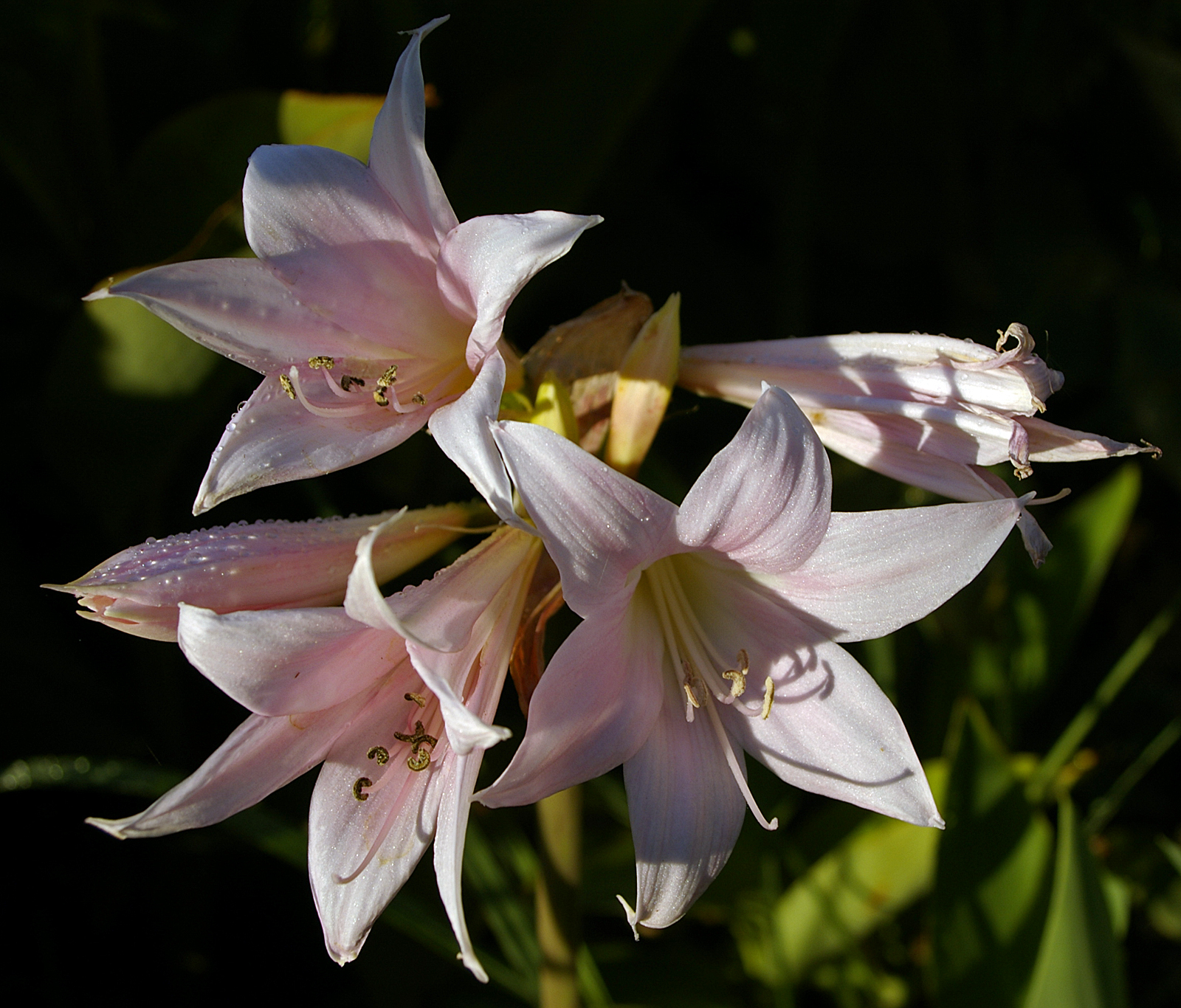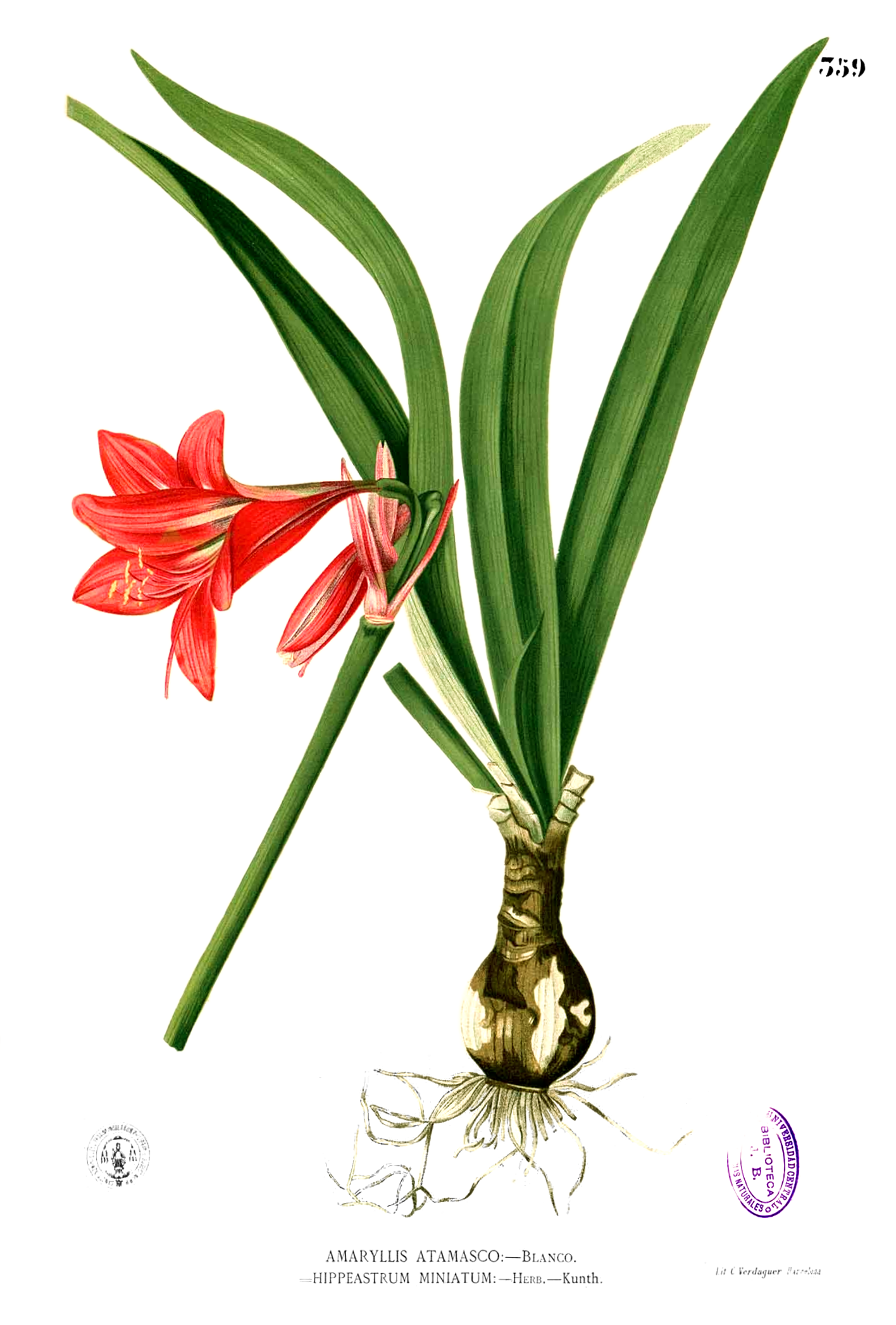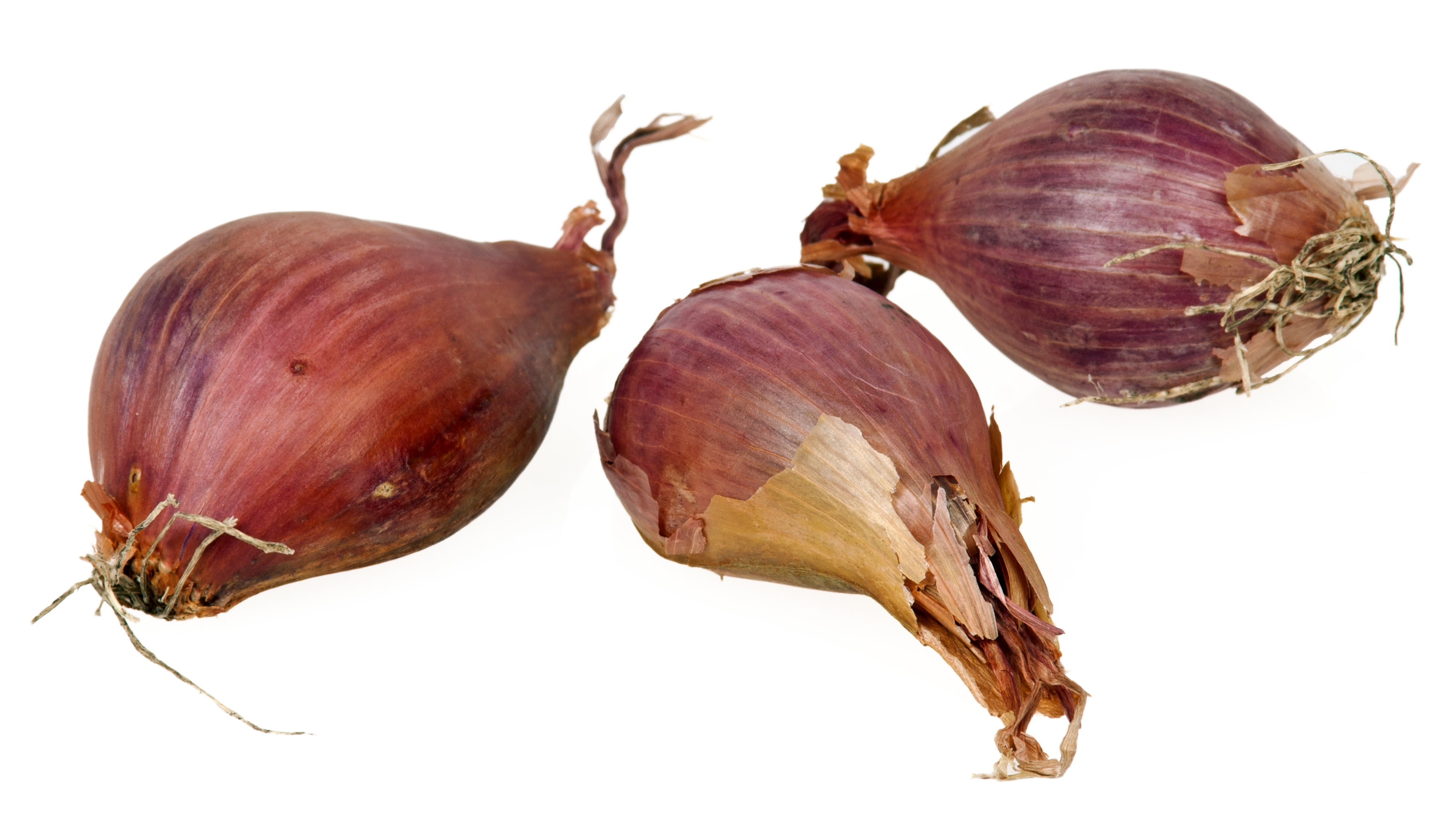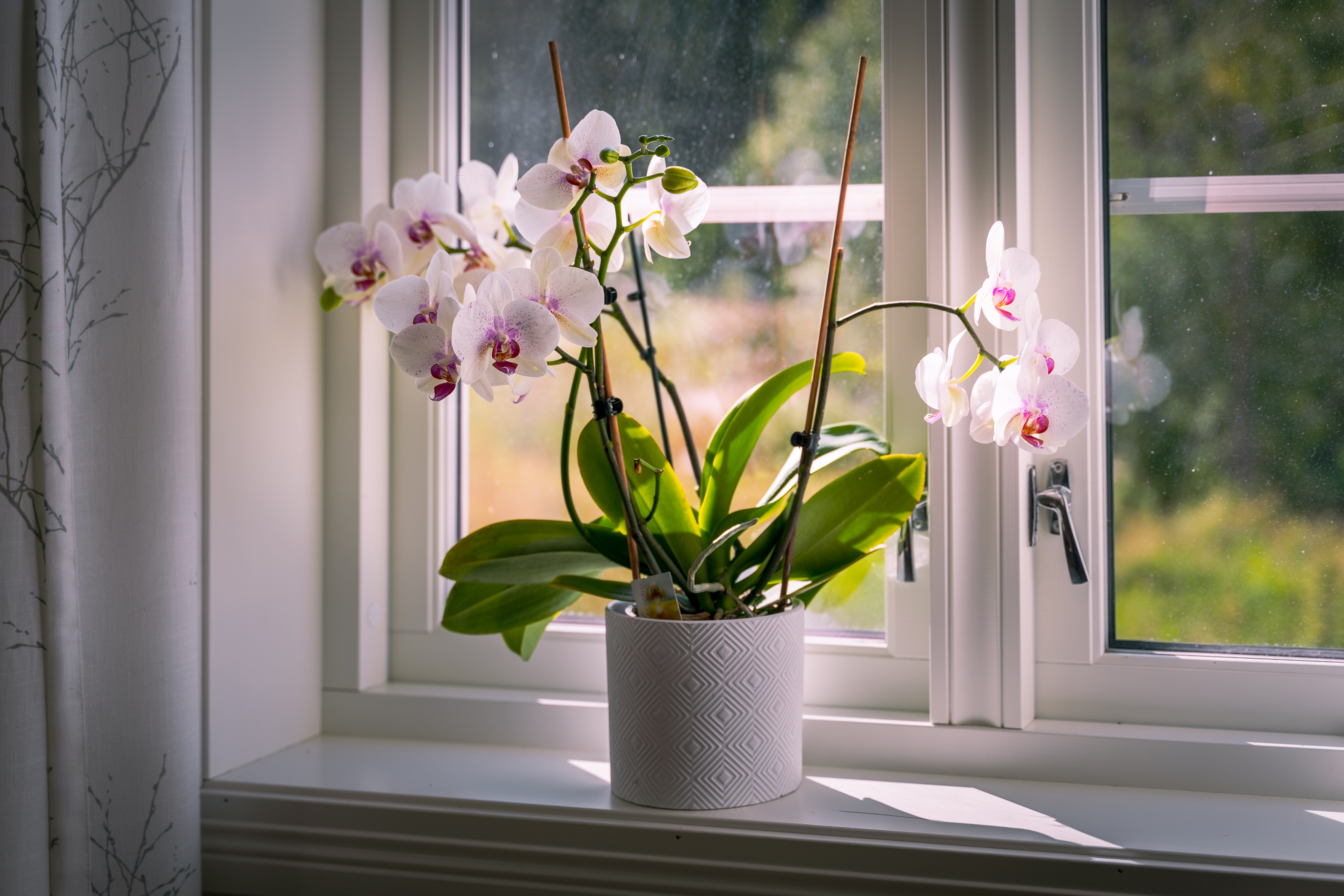|
Amaryllis
''Amaryllis'' () is the only genus in the subtribe Amaryllidinae (tribe Amaryllideae). It is a small genus of flowering bulbs, with two species. The better known of the two, '' Amaryllis belladonna'', is a native of the Western Cape region of South Africa, particularly the rocky southwest area between the Olifants River Valley and Knysna. For many years there was confusion among botanists over the generic names ''Amaryllis'' and ''Hippeastrum'', one result of which is that the common name 'amaryllis' is mainly used for cultivars of the genus ''Hippeastrum'', widely sold in the winter months for their ability to bloom indoors. Plants of the genus ''Amaryllis'' are known as belladonna lily, Jersey lily, naked lady, amarillo, Easter lily in Southern Australia or, in South Africa, March lily due to its propensity to flower around March. This is one of numerous genera with the common name 'lily' due to their flower shape and growth habit. However, they are only distantly related ... [...More Info...] [...Related Items...] OR: [Wikipedia] [Google] [Baidu] |
Hippeastrum
''Hippeastrum'' () is a genus of 116 species, and over 600 Hybrid (biology), hybrids and cultivars, of perennial plant, perennial, herbaceous plant, herbaceous and bulbous plants, native to tropical and subtropical regions of the Americas, from Mexico south to Argentina and on some islands in the Caribbean. The majority have large, fleshy bulbs and tall, broad, strap-like leaves that are (generally) evergreen, and large red or purple flowers. Numerous colors and cultivars have been created over the past hundred years. ''Hippeastrum'' is a genus in the Family (biology), family Amaryllidaceae (subfamily Amaryllidoideae, Tribe (biology), tribe Hippeastreae, and subtribe Hippeastrinae). For many years, there has been confusion among Botanist, botanists, as well as collectors and the general public, over the Genus, generic names ''Amaryllis'' and ''Hippeastrum''; the former is a Southern Africa, South African genus of plants, while the latter is a new world genus. However, the co ... [...More Info...] [...Related Items...] OR: [Wikipedia] [Google] [Baidu] |
Amaryllis Belladonna Flowers
''Amaryllis'' () is the only genus in the subtribe Amaryllidinae (tribe Amaryllideae). It is a small genus of flowering bulbs, with two species. The better known of the two, '' Amaryllis belladonna'', is a native of the Western Cape region of South Africa, particularly the rocky southwest area between the Olifants River Valley and Knysna. For many years there was confusion among botanists over the generic names ''Amaryllis'' and ''Hippeastrum'', one result of which is that the common name 'amaryllis' is mainly used for cultivars of the genus ''Hippeastrum'', widely sold in the winter months for their ability to bloom indoors. Plants of the genus ''Amaryllis'' are known as belladonna lily, Jersey lily, naked lady, amarillo, Easter lily in Southern Australia or, in South Africa, March lily due to its propensity to flower around March. This is one of numerous genera with the common name 'lily' due to their flower shape and growth habit. However, they are only distantly related ... [...More Info...] [...Related Items...] OR: [Wikipedia] [Google] [Baidu] |
Amaryllis Belladonna
''Amaryllis belladonna'', the Jersey lily, belladonna-lily, naked-lady-lily, or March lily, is a plant species native to Cape Province in South Africa but widely cultivated as an ornamental. It is reportedly naturalized in many places: Corsica, Portugal, the Azores, Madeira, the Canary Islands, the Scilly Isles of Great Britain, the Democratic Republic of the Congo, Ascension Island, Australia, New Zealand, Mexico, Cuba, Haiti, the Dominican Republic, Chile, California, Texas, Louisiana, Mississippi, Michigan and the Juan Fernández Islands. Description Perennial bulbous geophyte with one to two erect solid stems which appear in late summer. The inflorescence bears 2–12 showy fragrant funnel-shaped flowers on a 'naked' (leafless) stem, which gives it the common name of naked-lady-lily. The pink flowers which may be up to 10cm in length, appear in the autumn before the leaves ( hysteranthy) which are narrow and strap shaped. Taxonomy and etymology ''Amaryllis belladonna'' ... [...More Info...] [...Related Items...] OR: [Wikipedia] [Google] [Baidu] |
Bulb
In botany, a bulb is a short underground stem with fleshy leaves or leaf basesBell, A.D. 1997. ''Plant form: an illustrated guide to flowering plant morphology''. Oxford University Press, Oxford, U.K. that function as food storage organs during dormancy. In gardening, plants with other kinds of storage organ are also called ornamental bulbous plants or just ''bulbs''. Description The bulb's leaf bases, also known as scales, generally do not support leaves, but contain food reserves to enable the plant to survive adverse conditions. At the center of the bulb is a vegetative growing point or an unexpanded flowering shoot. The base is formed by a reduced stem, and plant growth occurs from this basal plate. Roots emerge from the underside of the base, and new stems and leaves from the upper side. Tunicate bulbs have dry, membranous outer scales that protect the continuous lamina of fleshy scales. Species in the genera ''Allium'', '' Hippeastrum'', '' Narcissus'', and ''Tulipa' ... [...More Info...] [...Related Items...] OR: [Wikipedia] [Google] [Baidu] |
Houseplant
A houseplant, also known as a pot plant, potted plant, or indoor plant, is an ornamental plant cultivated indoors. for aesthetic or practical purposes. These plants are commonly found in House, homes, Office, offices, and various indoor spaces, where they contribute to the ambiance by adding natural beauty and improving air quality. Most houseplants are tropical or semi-tropical species, as they thrive in the warm, humid conditions often found indoors. Many of them are Epiphyte, epiphytes(plants that grow on other plants), Succulent plant, succulents (which store water in their leaves), or Cactus, cacti, which are particularly well-suited to indoor environments due to their low maintenance requirements. Whether used to brighten up a space, improve air circulation, or create a calming atmosphere, houseplants play an important role in enhancing the indoor environment. Care Houseplants have care requirements that differ from plants grown outdoors. Moisture, light, soil mixture, tem ... [...More Info...] [...Related Items...] OR: [Wikipedia] [Google] [Baidu] |
Locule
A locule (: locules) or loculus (; : loculi) is a small cavity or compartment within an organ or part of an organism (animal, plant, or fungus). In angiosperms (flowering plants), the term ''locule'' usually refers to a chamber within an ovary (gynoecium or carpel) of the flower and fruits. Depending on the number of locules in the ovary, fruits can be classified as (uni-locular), , , or . The number of locules present in a gynoecium may be equal to or less than the number of carpels. The locules contain the ovules or seeds. The term may also refer to chambers within anthers containing pollen. In ascomycetous fungi, locules are chambers within the hymenium The hymenium is the tissue layer on the hymenophore of a fungal fruiting body where the cells develop into basidia or asci, which produce spores. In some species all of the cells of the hymenium develop into basidia or asci, while in oth ... in which the perithecia develop. References Plant anatomy Plant ... [...More Info...] [...Related Items...] OR: [Wikipedia] [Google] [Baidu] |
Ovule
In seed plants, the ovule is the structure that gives rise to and contains the female reproductive cells. It consists of three parts: the ''integument'', forming its outer layer, the ''nucellus'' (or remnant of the sporangium, megasporangium), and the female gametophyte (formed from a haploid megaspore) in its center. The female gametophyte — specifically termed a ''megagametophyte'' — is also called the ''embryo sac'' in Flowering plant, angiosperms. The megagametophyte produces an ovum, egg cell for the purpose of fertilization. The ovule is a small structure present in the ovary. It is attached to the placenta by a stalk called a funicle. The funicle provides nourishment to the ovule. On the basis of the relative position of micropyle, body of the ovule, chalaza and funicle, there are six types of ovules. Location within the plant In flowering plants, the ovule is located inside the portion of the flower called the gynoecium. The Ovary (plants), ovary of the gynoecium p ... [...More Info...] [...Related Items...] OR: [Wikipedia] [Google] [Baidu] |
Stigma (botany)
The stigma (: stigmas or stigmata) is the receptive tip of a Gynoecium#Carpels, carpel, or of several fused carpels, in the gynoecium of a flower. Description The stigma, together with the Style (botany), style and ovary (botany), ovary (typically called the stigma-style-ovary system) comprises the pistil, which is part of the gynoecium or female reproductive organ of a plant. The stigma itself forms the distal portion of the style, or stylodia, and is composed of , the cells of which are receptive to pollen. These may be restricted to the apex of the style or, especially in wind pollinated species, cover a wide surface. The stigma receives pollen and it is on the stigma that the pollen grain germination, germinates. Often sticky, the stigma is adapted in various ways to catch and trap pollen with various hairs, flaps, or sculpturings. The pollen may be captured from the air (wind-borne pollen, anemophily), from visiting insects or other animals (Pollination syndrome#Biotic, ... [...More Info...] [...Related Items...] OR: [Wikipedia] [Google] [Baidu] |
Chromosome
A chromosome is a package of DNA containing part or all of the genetic material of an organism. In most chromosomes, the very long thin DNA fibers are coated with nucleosome-forming packaging proteins; in eukaryotic cells, the most important of these proteins are the histones. Aided by chaperone proteins, the histones bind to and condense the DNA molecule to maintain its integrity. These eukaryotic chromosomes display a complex three-dimensional structure that has a significant role in transcriptional regulation. Normally, chromosomes are visible under a light microscope only during the metaphase of cell division, where all chromosomes are aligned in the center of the cell in their condensed form. Before this stage occurs, each chromosome is duplicated ( S phase), and the two copies are joined by a centromere—resulting in either an X-shaped structure if the centromere is located equatorially, or a two-armed structure if the centromere is located distally; the jo ... [...More Info...] [...Related Items...] OR: [Wikipedia] [Google] [Baidu] |
Connation
Connation in plants is the developmental fusion of organs of the same type, for example, petals to one another to form a tubular corolla. This is in contrast to adnation, the fusion of dissimilar organs. Such organs are described as connate or adnate, respectively. When like organs that are usually well separated are placed next to each other, but not actually connected, they are described as connivent (that is the case for anthers in several genera, such as ''Solanum''). Terms for connation of flower parts * Synsepalous: All the sepals of a flower are fused into a cup or tube; the fused portion is the calyx tube, and any non fused tips are the calyx lobes. *Sympetalous: All the petals of a flower are fused into a cup, tube, or other shape. *Stamens: **Synandrous: Stamens are fused in an unspecified manner **Synfilamentous: Stamens are fused by their filaments **Synantherous: Stamens are fused by their anthers *Syncarpous: Carpels are fused together to form a compound ovary ... [...More Info...] [...Related Items...] OR: [Wikipedia] [Google] [Baidu] |
Stamen
The stamen (: stamina or stamens) is a part consisting of the male reproductive organs of a flower. Collectively, the stamens form the androecium., p. 10 Morphology and terminology A stamen typically consists of a stalk called the filament and an anther which contains sporangium, microsporangia. Most commonly, anthers are two-lobed (each lobe is termed a locule) and are attached to the filament either at the base or in the middle area of the anther. The sterile (i.e. nonreproductive) tissue between the lobes is called the Connective (botany), connective, an extension of the filament containing conducting strands. It can be seen as an extension on the dorsal side of the anther. A pollen grain develops from a microspore in the microsporangium and contains the male gametophyte. The size of anthers differs greatly, from a tiny fraction of a millimeter in ''Wolfia'' spp up to five inches (13 centimeters) in ''Canna iridiflora'' and ''Strelitzia nicolai''. The stamens in a flower ... [...More Info...] [...Related Items...] OR: [Wikipedia] [Google] [Baidu] |
Tepal
A tepal is one of the outer parts of a flower (collectively the perianth). The term is used when these parts cannot easily be classified as either sepals or petals. This may be because the parts of the perianth are undifferentiated (i.e. of very similar appearance), as in ''Magnolia'', or because, although it is possible to distinguish an outer whorl of sepals from an inner whorl of petals, the sepals and petals have similar appearance to one another (as in ''Lilium''). The term was first proposed by Augustin Pyramus de Candolle in 1827 and was constructed by analogy with the terms "petal" and "sepal". (De Candolle used the term ''perigonium'' or ''perigone'' for the tepals collectively; today, this term is used as a synonym for ''perianth''.) p. 39. Origin Undifferentiated tepals are believed to be the ancestral condition in flowering plants. For example, ''Amborella'', which is thought to have separated earliest in the evolution of flowering plants, has flowers with undiffer ... [...More Info...] [...Related Items...] OR: [Wikipedia] [Google] [Baidu] |









